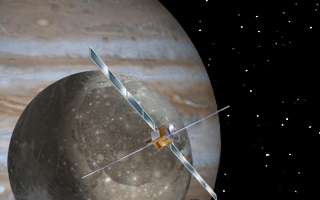Related Research Articles

Ariane 5 is a European heavy-lift space launch vehicle developed and operated by Arianespace for the European Space Agency (ESA). It is launched from the Centre Spatial Guyanais in French Guiana. It has been used to deliver payloads into geostationary transfer orbit (GTO) or low Earth orbit (LEO). The rocket had a streak of 82 consecutive successful launches between 9 April 2003 and 12 December 2017. A direct successor system, Ariane 6, is in development.
AsiaSat 3, previously known as HGS-1 and then PAS-22, was a geosynchronous communications satellite, which was salvaged from an unusable geosynchronous transfer orbit (GTO) by means of the Moon's gravity.
AsiaSat 2 was a Hong Kong communications satellite, which was owned, and was initially operated, by the Hong Kong based Asia Satellite Telecommunications Company. It was positioned in geostationary orbit at a longitude of 17° East of the Greenwich Meridian, on lease to Spacecom. It spent most of its operational life at 100.5° East, from where it was used to provide fixed satellite services, including broadcasting, audio and data transmission, to Asia and the Pacific Ocean.
AsiaSat 5 is a Hong Kong communications satellite, which is operated by the Hong Kong based Asia Satellite Telecommunications Company (AsiaSat). It is positioned in geostationary orbit at a longitude of 100.5° East of the Greenwich Meridian, where it replaced the AsiaSat 2 satellite. It is used to provide fixed satellite services, including broadcasting, telephone and broadband very small aperture terminal (VSAT) communications, to Asia and the Pacific Ocean region.
AMC-11 , previously GE-11, is an American geostationary communications satellite which is operated by SES S.A.. It is currently positioned in geostationary orbit at a longitude of 131° West, from where it is used to relay cable television across North America for onward distribution. It broadcasts to Canada, the Caribbean, Mexico and the United States.
Intelsat 2, formerly PAS-2, was a communications satellite operated by Intelsat which spent most of its operational life serving the Pacific Rim market from a longitude of 169° East. Launched in July 1994, the satellite was operated by PanAmSat until it merged with Intelsat in 2006. The spacecraft was renamed, along with the rest of PanAmSat's fleet, on 1 February 2007.
The Broadcasting Satellite System Corporation (B-SAT) is a Japanese corporation established in April 1993 to procure, manage and lease transponders on communications satellites. Its largest stockholder, owning 49.9%, is NHK, the Japan Broadcasting Corporation. In 1994, it was ranked by Space News as the world's 19th largest fixed satellite operator.
Astra 1M is a geostationary communications satellite which is operated by SES. It is positioned in geostationary orbit at a longitude of 19.2° East, from where it is used to provide direct to home (DTH) broadcasting to Europe, Africa, and the Middle East.
Ekspress-A2, also designated Ekspress-6A No 2 and sometimes erroneously called Ekspress-2A, is a Russian communications satellite which is operated by Russian Satellite Communications Company (RSCC). It was constructed by NPO PM and Alcatel Space and is based on the MSS-2500-GSO satellite bus.
TV-SAT 1 or TVSAT-1 was a West German communications satellite which was to have been operated by Deutsche Bundespost. It was intended to be used to provide television broadcast services to Europe, however it failed before entering service. It was constructed by Aérospatiale, based on the Spacebus 300 satellite bus, and carried five Ku-band transponders. At launch it had a mass of 2,144 kg (4,727 lb), and an expected operational lifespan of eight years.
Galaxy 11 is an American geostationary communications satellite which is operated by Intelsat. It is located in geostationary orbit at a longitude of 32.8 degrees east, where it serves as a backup to the Intelsat 802 spacecraft. It was originally operated at 99° West and later spent most of its operational life at 91° West, from where it was used to provide communications services to Brazil and North America.
SES-1 is a geostationary communications satellite which is operated by SES World Skies, then by SES S.A..
SES-7 is a commercial communications satellite operated by SES World Skies, then SES S.A.
Technology Education Satellite (TechEdSat) is a class of CubeSats built by San Jose State University and University of Idaho students in partnership with NASA's Ames Research Center. These satellites have tested communication technology for smallsats, and have contributed to the development of the Small Payload Quick Return (SPQR) concept.
SES-2 is a communications satellite operated by SES World Skies. It was launched alongside the Arabsat-5C satellite.
As of 21 June 2021, over eighty countries have operated artificial satellites.

This article documents expected notable spaceflight events during the year 2022.
SES-4 is a communications satellite operated by SES World Skies, then by SES S.A.
Ekspress-103 is a Russian communications satellite which was launched in 2020. Part of the Ekspress series of geostationary communications satellites, it is owned and operated by the RSCC Space Communications.
References
- ↑ McDowell, Jonathan. "Launch Log". Jonathan's Space Report. Retrieved 30 October 2013.
- ↑ "SES 3". N2YO.com. Retrieved 11 April 2021.
- ↑ Krebs, Gunter (11 December 2017). "SES 1, 2, 3". Gunter's Space Page. Retrieved 11 April 2021.
- ↑ "SES 3 at 103.0° W". LyngSat.